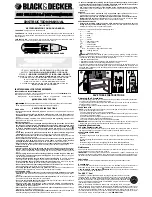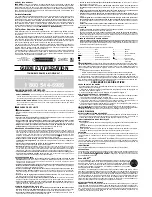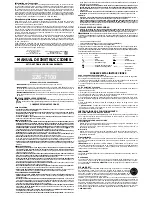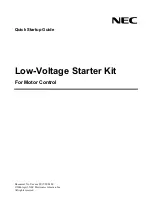
GENERAL SAFETY RULES
WARNING:
Read and understand all instructions. Failure to follow all instructions listed
below may result in electric shock, fire and/or serious personal injury.
SAVE THESE INSTRUCTIONS
WORK AREA
• Keep your work area clean and well lit. Cluttered benches and dark areas invite
accidents.
• Do not operate power tools in explosive atmospheres, such as in the presence of
flammable liquids, gases, or dust. Power tools create sparks which may ignite the dust or
fumes.
• Keep bystanders, children, and visitors away while operating a power tool.
Distractions can cause you to lose control.
ELECTRICAL SAFETY
• Double Insulated tools are equipped with a polarized plug (one blade is wider than
the other). This plug will fit in a polarized outlet only one way. If the plug does not fit
fully in the outlet, reverse the plug. If it still does not fit, contact a qualified electrician
to install a polarized outlet. Do not change the plug in any way. Double Insulation
eliminates the need for the three wire grounded power cord and grounded power supply
system.
• Avoid body contact with grounded surfaces such as pipes, radiators, ranges and
refrigerators. There is an increased risk of electric shock if your body is grounded.
• Don’t expose power tools to rain or wet conditions. Water entering a power tool will
increase the risk of electric shock.
• Do not abuse the cord. Never use the cord to carry the tools or pull the plug from an
outlet. Keep cord away from heat, oil, sharp edges or moving parts. Replace
damaged cords immediately. Damaged cords increase the risk of electric shock.
• When operating a power tool outside, use an outdoor extension cord marked "W-A"
or "W". These cords are rated for outdoor use and reduce the risk of electric shock.
PERSONAL SAFETY
• Stay alert, watch what you are doing and use common sense when operating a power
tool. Do not use tool while tired or under the influence of drugs, alcohol, or medica-
tion. A moment of inattention while operating power tools may result in serious personal
injury.
• Dress properly. Do not wear loose clothing or jewelry. Contain long hair. Keep your
hair, clothing , and gloves away from moving parts. Loose clothes, jewelry, or long hair
can be caught in moving parts.
• Avoid accidental starting. Be sure switch is off before plugging in. Carrying tools with
your finger on the switch or plugging in tools that have the switch on invites accidents.
• Remove adjusting keys or wrenches before turning the tool on. A wrench or a key that
is left attached to a rotating part of the tool may result in personal injury.
• Do not overreach. Keep proper footing and balance at all times. Proper footing and bal-
ance enables better control of the tool in unexpected situations.
• Use safety equipment. Always wear eye protection. Dust mask, non-skid safety shoes,
hard hat, or hearing protection must be used for appropriate conditions.
TOOL USE AND CARE
• Use clamps or other practical way to secure and support the workpiece to a stable
platform. Holding the work by hand or against your body is unstable and may lead to loss of
control.
• Do not force tool. Use the correct tool for your application. The correct tool will do the
job better and safer at the rate for which it is designed.
• Do not use tool if switch does not turn it on or off. Any tool that cannot be controlled with
the switch is dangerous and must be repaired.
• Disconnect the plug from the power source before making any adjustments,
changing accessories, or storing the tool. Such preventive safety measures reduce the
risk of starting the tool accidentally.
• Store idle tools out of reach of children and other untrained persons. Tools are
dangerous in the hands of untrained users.
• Maintain tools with care. Keep cutting tools sharp and clean. Properly maintained tools
with sharp cutting edges are less likely to bind and are easier to control.
• Check for misalignment or binding of moving parts, breakage of parts, and any other
condition that may affect the tool’s operation. If damaged, have the tool serviced before
using. Many accidents are caused by poorly maintained tools.
• Use only accessories that are recommended by the manufacturer for your model.
Accessories that may be suitable for one tool may become hazardous when used on
another tool.
SERVICE
• Tool service must be performed only by qualified repair personnel. Service or
maintenance performed by unqualified personnel could result in a risk of injury.
• When servicing a tool, use only identical replacement parts. Follow instructions in
the Maintenance section of this manual. Use of unauthorized parts or failure to follow
Maintenance Instructions may create a risk of electric shock or injury.
SPECIFIC SAFETY RULES
• Hold tool by insulated gripping surfaces when performing an operation where the
cutting tool may contact hidden wiring. Contact with a "live" wire will also make exposed
metal parts of the tool "live" and shock the operator.
The label on your tool may include the following symbols.
V..............volts
A..............amperes
Hz............hertz
W ............watts
min ..........minutes
............alternating current
........direct current
no ............no load speed
............Class II Construction
…/min......revolutions or reciprocation per minute
............earthing terminal
............safety alert symbol
WARNING: Some dust created by power sanding, sawing, grinding, drilling, and other
construction activities contains chemicals known to cause cancer, birth defects or other
reproductive harm. Some examples of these chemicals are:
• lead from lead-based paints,
• crystalline silica from bricks and cement and other masonry products, and
• arsenic and chromium from chemically-treated lumber. (CCA)
Your risk from these exposures varies, depending on how often you do this type of work. To
reduce your exposure to these chemicals: work in a well ventilated area, and work with
approved safety equipment, such as those dust masks that are specially designed to filter out
microscopic particles.
SAVE THESE INSTRUCTIONS
Charging the Screwdriver
Before attempting to charge your screwdriver, thoroughly read all of the safety instructions.
To charge your screwdriver, follow the steps below.
1. Plug the output cord of the charger into the socket in the back half of the screwdriver
handle as shown in Figure 1.
2. Plug the charger into any standard electrical outlet as depicted in Figure 2.
CHARGING NOTES
NOTE: The tool was sent from the factory in an uncharged condition. Before attempting to
use it, it must be charged for 12 hours.
1. Charger will work best at normal room temperature.
2. The charger plug and the tool handle may become warm while charging. This is normal
and does not indicate a problem.
3. The tool can be left on charge as long as you desire. A minimum charge time of 12 hours is
required to recharge a completely discharged tool.
4. For most fix up jobs a charge of 3 to 4 hours will be adequate.
WARNING: When disconnecting the screwdriver from the charger, be sure to unplug the
charger from the outlet first then disconnect the charger cord from the screwdriver.
Operating Instructions
REMOVING AND INSTALLING BITS
To install a bit simply insert it into the cavity in the spindle until it snaps into place. To remove
the bit pull it straight out. If bit does not fit into spindle, rotate the bit and re-insert it.
OPERATING IN POWER MODE
Forward
• Slide the orange button to the right, as shown in Figure 3 aligning it with the arrow pointing
forward.
• Press the orange button and the tool will run; release the button and the tool will stop.
Reverse
• Slide the orange button to the left, aligning it with the arrow pointing backward.
• Press the orange button and the tool will run; release the button and the tool will stop.
Maintenance
Use only mild soap and damp cloth to clean the tool. Never let any liquid get inside the tool;
never immerse any part of the tool into a liquid.
IMPORTANT:
To assure product SAFETY and RELIABILITY, repairs, maintenance and
adjustment (other than those listed in this manual) should be performed by authorized serv-
ice centers or other qualified service organizations, always using identical replacement parts.
Lubrication
Black & Decker tools are properly lubricated at the factory and are ready for use.
Accessories
Recommended accessories for use with your tool are available from your local dealer or
authorized service center. If you need assistance regarding accessories, please call:
1-800-54-HOW-TO. (800-544-6986)
CAUTION: The use of any accessory or attachment
not recommended may be hazardous.
The RBRC™ Seal
The RBRC™ (Rechargeable Battery Recycling Corporation) Seal on the nickel-
cadmium battery (or battery pack) indicates that the costs to recycle the battery
(or battery pack) at the end of its useful life have already been paid by Black &
Decker. In some areas, it is illegal to place spent nickel-cadmium batteries in the
trash or municipal solid waste stream and the RBRC program provides an envi-
ronmentally conscious alternative.
RBRC in cooperation with Black & Decker and other battery users, has estab-
lished programs in the United States and Canada to facilitate the collection of spent nickel-
cadmium batteries. Help protect our environment and conserve natural resources by return-
ing the spent nickel-cadmium battery to an authorized Black & Decker service center or to
your local retailer for recycling. You may also contact your local recycling center for informa-
tion on where to drop off the spent battery, or call
1-800-8-BATTERY
.
INSTRUCTION MANUAL
Cat. No. 9071
KEY INFORMATION YOU SHOULD KNOW:
TO CHARGE: Charge 12 hours before first use.
TO OPERATE: The orange button must be in the forward/reverse position and depressed to
operate tool in either direction. When the button is in the center, it is in a safety position and
will not operate.
TO INSTALL A BIT : Insert bit firmly into the cavity in the spindle until it snaps into place. If
the bit does not fit into the spindle, rotate the bit and re-insert it.
SAVE THIS MANUAL FOR FUTURE REFERENCE
1
2
3
4
9
9
9
9
0
0
0
0
7
7
7
7
1
1
1
1
C
C
C
C
O
O
O
O
R
R
R
R
D
D
D
D
L
L
L
L
E
E
E
E
S
S
S
S
S
S
S
S
2
2
2
2
..
..
4
4
4
4
V
V
V
V
O
O
O
O
L
L
L
L
T
T
T
T
S
S
S
S
C
C
C
C
R
R
R
R
E
E
E
E
W
W
W
W
D
D
D
D
R
R
R
R
II
II
V
V
V
V
E
E
E
E
R
R
R
R
Catalog No. 9071 Form No. 606990-00-00 (AUG-01) Copyright © 2001 Printed in China
VEA EL ESPAÑOL EN LA CONTRAPORTADA.
SAVE THIS MANUAL FOR FUTURE REFERENCE.
INSTRUCTIVO DE OPERACIÓN, CENTROS DE SERVICIO Y PÓLIZA DE GARANTÍA.
ADVERTENCIA:
LÉASE
ESTE INSTRUCTIVO ANTES DE USAR EL PRODUCTO.
1-800-54-HOW-TO
BEFORE RETURNING THIS PRODUCT
FOR ANY REASON PLEASE CALL
IF YOU SHOULD EXPERIENCE A PROBLEM
WITH YOUR BLACK & DECKER PURCHASE,
CALL 1-800-54-HOW-TO (1-800-544-6986).
IN MOST CASES, A BLACK & DECKER REPRESENTATIVE
CAN RESOLVE YOUR PROBLEM OVER THE PHONE.
IF YOU HAVE A SUGGESTION OR COMMENT,
GIVE US A CALL. YOUR FEEDBACK IS VITAL
TO THE SUCCESS OF BLACK & DECKER'S QUALITY
IMPROVEMENT PROGRAM.
(544-6986)






















